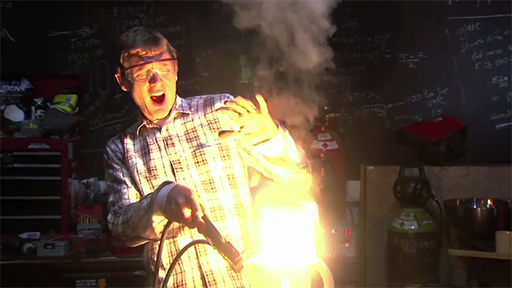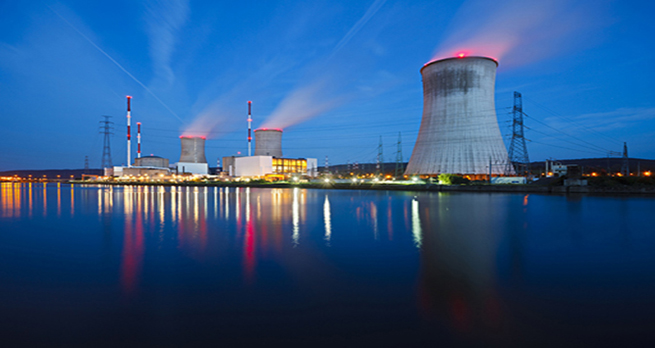3.2.2 Hydrogen explosions demonstration
Download this video clip.Video player: ou_futurelearn_nuclear_energy_vid_1061.mp4


Transcript
[AUDIO FUZZ]
EMILY MAITLISS
Concerns are now being raised over three separate nuclear reactors at Fukushima, following an explosion at one yesterday. There are worries that the reactors could overheat, leading to meltdown.
[AUDIO FUZZ]
BBC CORRESPONDENT
So serious are the shortages of power, from tomorrow, the government will start rationing it here. In Tokyo and around the country, there'll be planned power cuts lasting for three hours in each place. They're warning the restrictions on energy usage could last for weeks.
[AUDIO FUZZ]
DAVID SHUKMAN
The building housing Number 1 exploded yesterday, and officials say a partial meltdown of the nuclear fuel may have happened. Number 2 reactor has a water level that's too low, so more is being pumped inside it.
[AUDIO FUZZ]
DAVID SHUKMAN
The authorities tackling the crisis at Fukushima have increased the size of the zone which may be at risk from 10 kilometres to 20. Hundreds of thousands of people are being moved out.
[AUDIO FUZZ]
DAVID SHUKMAN
The third reactor, that's causing greatest anxiety right now. It's impossible to know exactly what's going on inside it. But the flow of cooling water clearly stopped, the fuel rods will have heated up, and officials say it's possible they started to melt.
[AUDIO FUZZ]
HUW EDWARDS
The Japanese authorities underestimated the risk that a nuclear plant could be hit by a tsunami, and that sea defences were inadequate. That's the view of the UN Nuclear Energy Agency in its official report, but the investigators go on to say that the response to the crisis, which struck on the 11th of March, was exemplary.
JEM STANSFIELD
So, what was it that went wrong at Japan's Fukushima reactor? To find out, I headed back to the workshop for a bit of experimentation.
[EXPLOSION]
This is pretty much what created those very dramatic-looking explosions - an unfortunate mixture of hydrogen and oxygen coming into contact with something hot. The big difference is theirs involved about a million times more hydrogen and risked splitting far more than my eardrums. But what possible course of events could have resulted in a nuclear power station releasing a tonne of hydrogen?
[EXPLOSION]
In the case of Fukushima, a massive earthquake struck, and all the main power went out. You can imagine the scenario. Now, the good news is that these reactors are fitted with a kind of automatic break. And in the case of an emergency, neutron-absorbing rods are immediately inserted between the fuel rods, shutting down the main reaction.
But the bad news is you cannot just totally switch off a nuclear reactor. Because all the time it had been working, the uranium in there would have been producing a whole host of radioactive byproducts. And these continue splitting and giving off heat long after the main reaction has been shot off.
Now, this is known as decay heat. And even though it's only about one and a half per cent of the normal running power of the reactor, it still equates to about 20 megawatts. That's the equivalent of having about 10,000 kettles still boiling away in there.
But even 10,000 kettles worth of heat is not a problem, provided you've got plenty of water circulating through the reactor, taking that heat away. And even after the earthquake, those pumps pumping water were still working fine, running off backup generators. But 40 minutes later, the tsunami hits, wiping out the backup generators and the electrical switch gear. This meant, now, there was no water circulating through the reactor. And just like this kettle, it was beginning to boil dry.
That exposed electrical element is a bit like the nuclear fuel rods in the reactor. And as you can see, it's just getting hotter and hotter. In the reactor, the temperature soon reached 1,200 degrees Celsius, at which point fuel assemblies start to crack.
At 1,300 degrees Celsius, something even more serious started to happen. Surrounding the uranium fuel pellets is a metal called zirconium. And at those extreme temperatures, the zirconium gets so hot that it begins to chemically react with the steam inside the reactor, producing the extremely flammable gas hydrogen. Now you've got both steam and hydrogen being produced in the reactor vessel, and the pressure is going up dramatically, leaving the engineers with an extremely difficult dilemma.
Here's a model we've made to demonstrate the problem. Now, this is my reactor core. I'm going to pop that inside my nuclear plant.
[MUSIC PLAYING]
Inside the model, I've put some reactive metal to simulate the zirconium. And if I add some acid, it will start producing hydrogen gas in much the same way. And I've recreated their problem.
Now, already, that's getting dangerously high, which leaves me in a very similar position to the Japanese were. I've got to release the pressure in there, because the worst case scenario is that--
[HISSING]
[SIGHS]
That reactor vessel bursts due to the pressure built up inside it.
The workers at Fukushima had avoided the worst-case scenario.
Bursting under pressure and spraying superheated nuclear material out. But some of the gases they released into the chimney flowed back into the building and created a new danger.
That gas I've vented off is hydrogen. And when that mixes with air and comes into contact with any kind of spark, you have a potentially explosive situation.
[MUSIC INTENSIFIES]
[EXPLOSION]
Oh! Dramatic and powerful as a hydrogen explosion is, it really is just rapidly burning gas. And it's reassuring to know that, even with a horrendous natural disaster, there are enough control measures built into the plant that engineers could prevent excess pressure from bursting the actual reactor itself. And more importantly, the materials used in nuclear power mean that these places can never become nuclear bombs.
Interactive feature not available in single page view (see it in standard view).
The three explosions at Fukushima caused a great deal of damage. The video illustrates how dramatic a hydrogen explosion can be!
In 2011, TEPCO who owned the Daiichi plant would declare that cooling systems for reactors 1–4 were beyond repair and would have to be replaced.
The video in the next section shows the damage within the Daiichi plant.
